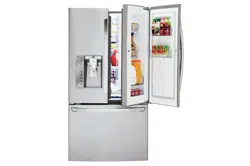Documents: Go to download!
- User Manual - (English)
- PRODUCT FEATURES
- PRODUCT SPECIFICATIONS
- PRODUCT OVERVIEW
- INSTALLATION
- OPERATION
- SMART FUNCTIONS
- MAINTENANCE
- TROUBLESHOOTING
Table of contents
OWNER'S MANUAL
PRODUCT FEATURES
Depending on the model, some of the following functions may not be available.
FILTERED WATER AND ICE DISPENSER
The water dispenser dispenses fresh, chilled water.
The ice dispenser dispenses cubed and crushed ice.
DOOR ALARM
The Door Alarm function is designed to prevent refrigerator malfunctioning that could occur if a refrigerator door or freezer drawer remains open. If a refrigerator door or freezer drawer is left open for more than 60 seconds, a warning alarm sounds at 30-second intervals.
HUMIDITY CONTROLLED CRISPERS
The Humidity Controlled Crispers are designed to help keep fruits and vegetables fresh and crisp. Control the amount of humidity in the crispers by adjusting the settings between Fruit (Low) and Vegetables (High).
GLIDE‘N’SERVE
The Glide‘N’Serve provides storage space with a variable temperature control that keeps the compartment colder than the refrigerator. It is a convenient place to store sandwiches or meat to be cooked.
AUTO-CLOSING HINGE
The refrigerator doors and freezer drawers close automatically with a slight push. (The door only closes automatically when it is open at an angle less than 30°.)
ICE PLUS
Ice production is increased when the freezer section is maintained at the coldest temperature for a 24-hour period.
PRODUCT SPECIFICATIONS
The apperance and specificationslisted in this manual may vary due to constant product improvements
Electrical requirements: 115 V, 60 Hz
Min. / Max. water pressure: 20 - 120 psi (138 - 827 kPa)
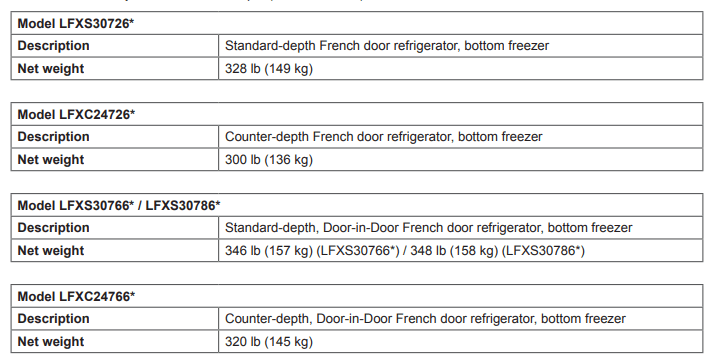
PRODUCT OVERVIEW
The images in this guide may be different from the actual components and accessories, which are subject to change by the manufacturer without prior notice for product improvement purposes.
Exterior
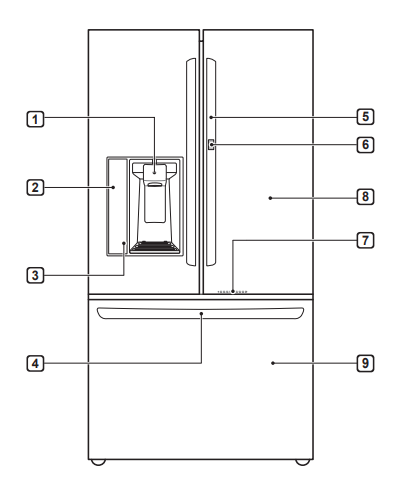
1. Filtered Water and Ice Dispenser
Dispenses purified water and ice
2. LED Display
Displays the refrigerator and freezer temperature, the water filter condition and the dispenser mode.
3. Control Panel
Sets the refrigerator and freezer temperatures, the water filter condition and the dispenser mode
4. EZ Handle
Easily opens the freezer door
5. Handle
Opens and closes the refrigerator door
6. Door button (On Some Models)
Opens the Door-in-Door Compartment
7. LED Light
LED lights up when the freezer door is opened
8. Refrigerator
Fresh food compartment
9. Freezer
Frozen food compartment
Interior
Standard Door : LFXS30726* / LFXC24726*
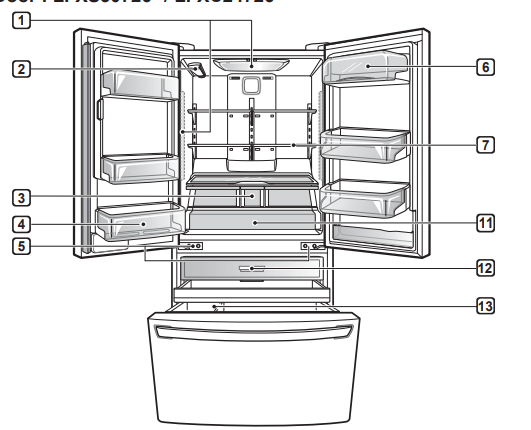
Door-in-Door : LFXS30766* / LFXS30786*/ LFXC24766*
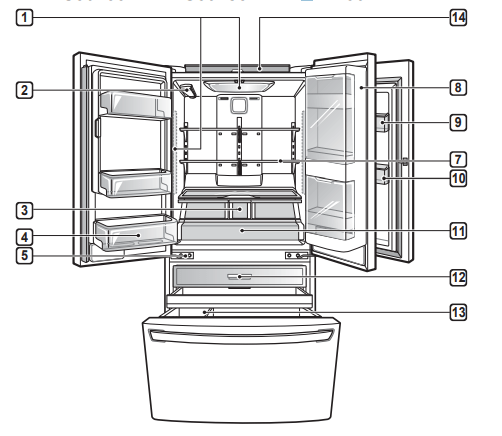
1. LED interior lamps
Light up the inside of the refrigerator.
2. Water filter
Purify water.
NOTE
- The filter should be replaced every 6 months. See the Replacing the Water Filter section in this manual for details
3.Crisper
Help vegetables and fruit to stay crisp.
Humidity Controlled Crisper (On Some Models)
Help vegetables and fruit to stay crisp and controls humidity.
4. Fixed Door Bin
Store chilled food or drinks
5. Auto-Closing Hinge (On Some Models)
The refrigerator doors and freezer drawers close automatically when pushed slightly (The door only closes automatically when it is open at an angle of less than 30°)
6. Dairy Bin
Store dairy products
7. Adjustable Refrigerator Shelf
The refrigerator shelves are adjustable to meet individual storage needs
8. Door-in-Door Case
A convenient storage area for frequently-used items that require easy access
9. Cheese & Butter and Condiment Bins
Cheese & Butter and Condiment bins are specially designed for these items, making spreading butter and slicing cheese easier
10. Modular Door Bin
Interchangeable bins can be arranged to suit storage needs.
11. Glide'N'Serve
Store food items at a different temperature than the regular refrigerator area.
12. Pullout Drawer
Provide extra storage within the freezer compartment.
13. Durabase and Durabase Divider
Provide storage for large food items.
14. Bluetooth Speaker (On Some Models)
Refer to the speaker manual packed with the refrigerator.
INSTALLATION
Installation Overview
Please read the following installation instructions first after purchasing this product or transporting it to another location.
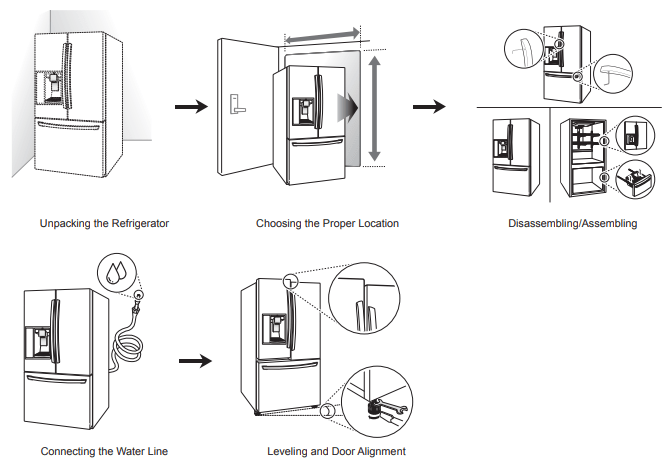
Unpacking the Refrigerator
Choosing the Proper Location
Water
Water supply must be easily connected for the automatic icemaker.
Electricity
Use an individual, grounded outlet:115 Volts, 60 Hz, AC, 15 Amps minimum.
Flooring
To avoid noise and vibration, the unit must be installed and leveled on a solidly constructed floor. If required, adjust the leveling legs to compensate for the unevenness of the floor.
NOTE
Installing on carpeting, soft tile surfaces, a platform or weakly supported structure is not recommended.
Ambient Temperature
Install this appliance in an area where the temperature is between 55 °F (13 °C) and 110 °F (43 °C).
If the temperature around the appliance is too low or high, cooling ability may be adversely affected.
Dimensions and Clearances
- Check the dimensions of the appliance and the installation path to ensure there is sufficient room to move the refrigerator through doors or narrow openings.
- If an opening is too narrow to fit the refrigerator through, remove the refrigerator doors. See Removing/ Assembling the Doors and Drawers in this manual.
- The installation location chosen for the refrigerator should allow space behind the unit for connections and airflow and space in front to open the doors and drawers.
- Too small of a distance from adjacent items may result in lowered freezing capability and increased electricity consumption charges. Allow at least 24 inches (610 mm) in front of the refrigerator to open the doors, and at least 2 inches (50.8 mm) between the back of the refrigerator and the wall.
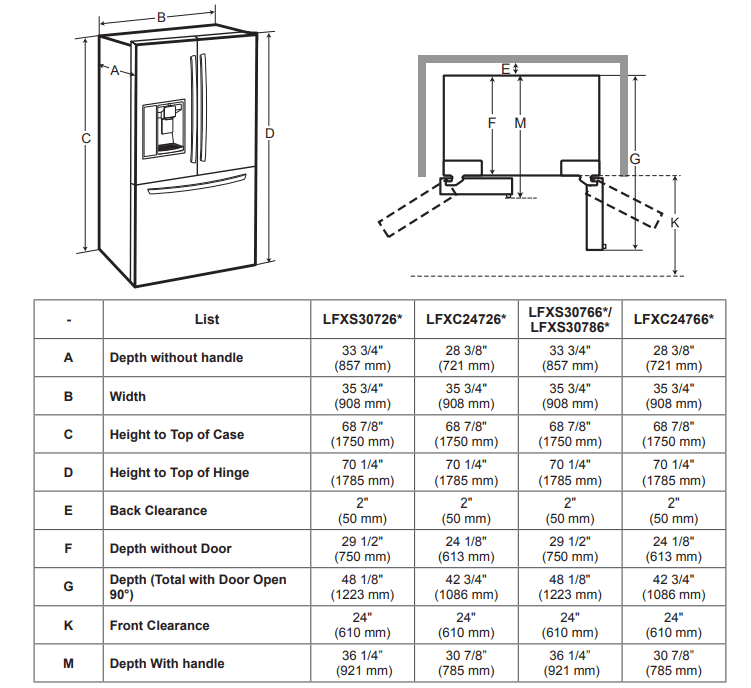
Removing/Assembling Handles
- When moving the refrigerator through a narrow opening, removing the doors is preferred.
- The appearance of the handles may vary from what is shown.
Tools Needed
3/32 in. Allen wrench
1/8 in. Allen wrench
1/4 in. Allen wrench
Removing the Refrigerator Handles
- Loosen the set screws (1) with a 3/32 in. Allen wrench and remove the handle.
- Loosen the mounting fasteners (2) that connect to the refrigerator door and handle using a 1/4 in. Allen wrench, and remove the mounting fasteners.

Assembling the Refrigerator Handles
- Assemble the mounting fasteners (1) at both ends of the handle with a 1/4 in. Allen rench.
- Place the handle on the door by fitting the handle footprints over the mounting fasteners and tightening the set screws (2) with a 3/32 in. Allen wrench.

Removing the Freezer Drawer Handle
- Loosen the set screws (1) located on the lower side of the handle with a 1/8 in. Allen wrench and remove the handle.
- Loosen the mounting fasteners (2) with a 1/4 in. Allen wrench, and remove the mounting fasteners.

Assembling the Freezer Drawer Handle
- Assemble the mounting fasteners (1) at both ends of the handle with a 1/4 in. Allen wrench.
- Place the handle on the door by fitting the handle footprints over the mounting fasteners and tightening the set screws (2) with a 1/8 in. Allen wrench.
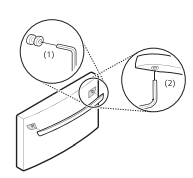
Removing/Assembling the Doors and Drawers
If the entrance door is too narrow for the refrigerator to pass through, remove the refrigerator doors and move the refrigerator sideways through the doorway.
Tools Needed
3/32 in. Allen wrench
1/8 in. Allen wrench
1/4 in. Allen wrench
Removing the Left Refrigerator Door
- The water supply is connected to the upper right part of the rear surface of the refrigerator. Remove the ring in the joint area. Hold the water supply connection and gently push the collet (1)to detach the water supply line (2) as shown.
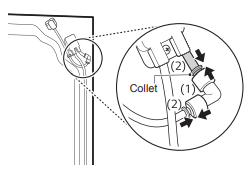
2. Remove the screw (1) from the hinge cover at the top of the refrigerator. Lift the hook (not visible), located at the bottom of the front side of the cover witha flat-head screwdriver .
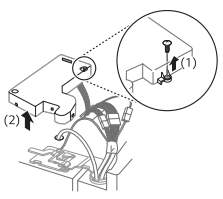
3. Remove the cover and pull out the tube (1). Disconnect all wire harnesses (2). Unscrew the ground wire (3).
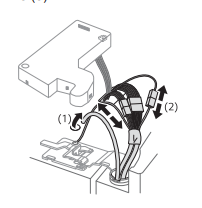
4. Rotate the hinge lever counterclockwise (1). Lift the top hinge (2) free of the hinge lever latch.

5. Lift the door from the middle hinge pin and remove the door.
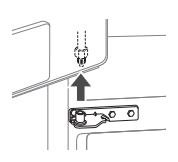
NOTE
Disassembling/Assembling the Water Lines
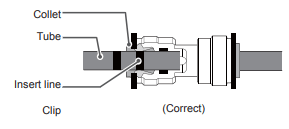
Removing the Right Refrigerator Door
- Remove the top hinge cover screw (1). Lift the hook (not visible), located at the bottom of the front side of the cover (2) , with a flat-head screwdriver.
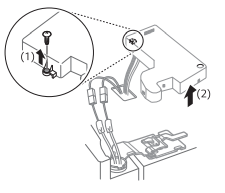
2. Detach the wire harness (1).
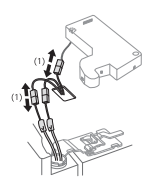
3.Rotate the hinge lever (1) clockwise. Lift the top hinge (2) free of the hinge lever latch.
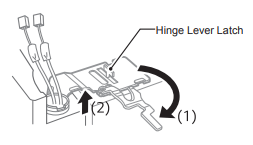
4. Lift the door from the middle hinge pin and remove the door.
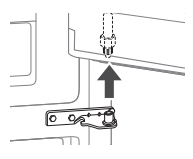
Assembling the Right Refrigerator Door
Install the right-side door first
- Make sure that the plastic sleeve is inserted in the bottom of the door. Lower the door onto the middle hinge pin as shown in the figure
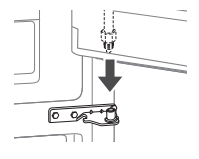
2. Fit the hinge (1) over the hinge lever latch and slot it into place. Rotate the lever (2) counterclockwise to secure the hinge.
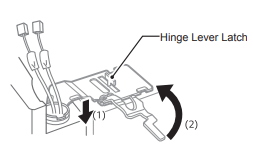
3. Connect the wire harness (1)

4. Place the cover (1) in its place. Insert and tighten the cover screw (2).
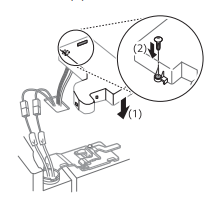
Install the left refrigerator door after the right door is installed.
- Make sure that the plastic sleeve is inserted in the bottom of the door. Install the refrigerator door onto the middle hinge.
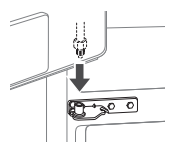
2. Fit the hinge (1) over the hinge lever latch and slot it into place. Rotate the lever clockwise (2) and fasten the hinge.
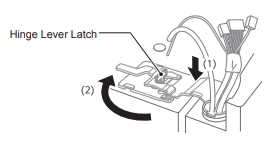
3. Connect all the wire harnesses.
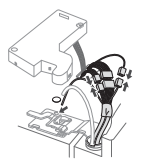
4. Push the water supply tube into the hole on the top case and pull it through the backplate.
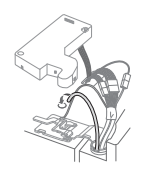
5.Hold the water supply connection and gently push in the collet (1) to connect the water supply line as shown. Insert the tube at least 5/8 inch (15 mm) into the connector. Insert the clip on the joint to fasten the tube in place.
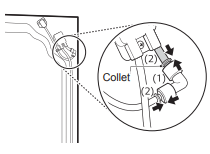
6. Place the cover (1) in place. Insert and tighten the cover screw (2).
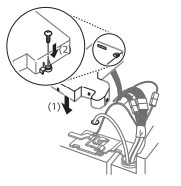
Disassembling/Assembling the Water Lines
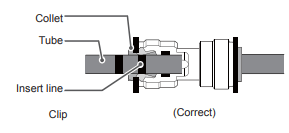
- Gently press the collet and insert the tube until only one line shows on the tube.

Removing the Freezer Drawers
The Pullout Drawer located above the freezer drawer is not shown for clarity.
- Pull the drawer open to full extension.
- Gently lift and pull out the ice bin.
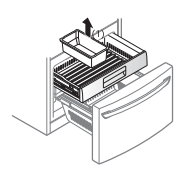
3. On the left rail, use a flat blade screwdriver to push in on the tab to release the drawer from the rail, as shown below. Once the left side is loose, push the tab on the right side with your fingure to release the drawer. Lift the front of the drawer up, then pull it straight out.
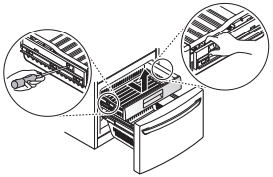
4. Remove the Durabase basket from the rails. Remove the screws from the rails at both ends.
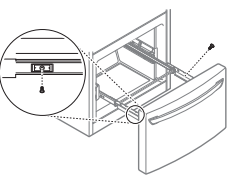
5.Grip both sides of the drawer and pull it up to remove it from the rails.
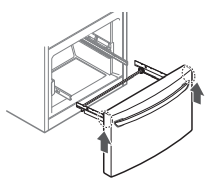
6. Hold both rails and push them in simultaneously.
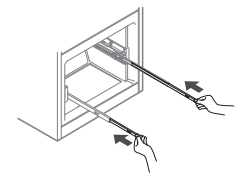
Assembling the Freezer Drawer
1.Pull out both rails simultaneously, until they are fully extended.

2.Grasp the drawer on each side and hook the drawer supports into the rail tabs located on both sides.
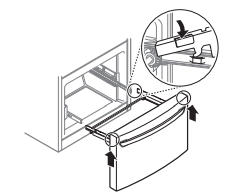
3.Lower the door into its final position and tighten the screws located on both sides

4.Insert the drawer into the frame, and push the drawer back until it clicks into place.
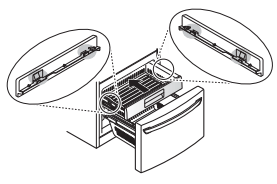
5.Replace the ice bin in the drawer. Insert the Durabase basket in the rail assembly
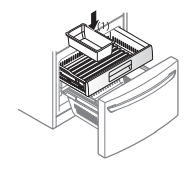
Connecting the Water Line
Before Beginning
This water line installation is not covered by the refrigerator warranty. Follow these instructions carefully to minimize the risk of expensive water damage.
If necessary, call a qualified plumber to correct water hammer before installing the water supply line to the refrigerator. Water banging in the pipes, or water hammer in residential plumbing can cause damage to refrigerator parts and lead to water leakage or flooding.
- Tum the icemaker OFF if the refrigerator will be used before the water line is connected.
- Do not install the icemaker tubing in areas where the ambient temperatures fall below freezing.
Water Pressure
You will need a cold water supply
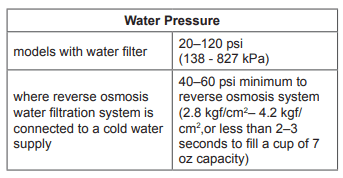
If the water pressure from the reverse osmosis system is less than 20 psi or 138 kPa or 1.4 kgf/cm² takes more than 4 seconds to fill a cup of 7 oz or 198 cc capacity):
- Check to see if the sediment filter in the reverse osmosis system is blocked. Replace the filter if necessary.
- Allow the storage tank on the reverse osmosis system to refill after heavy usage.
- If the water pressure remains low, call a licensed, qualified plumber.
- All installations must be in accordance with local plumbing code requirements.
Supplies Needed
Copper or PEX Tubing, 4 in. outer diameter, to connect the refrigerator to the water supply. Be sure both ends of the tubing are cut square. To determine how much tubing you need, measure the distance from the water valve on the back of the refrigerator to the water supply pipe. Then, add 8 feet (2.4 m). Be sure there is sufficient extra tubing (about 8 feet [2.4 m] coiled into 3 turns of about 10 in. [25 cm] diameter) to allow the refrigerator to move out from the wall after installation.
- Power drill.
- 1/2 in. or adjustable wrench.
- Flat-blade and Phillips-head screwdrivers.
- Two in. outer diameter compression nuts and 2 ferrules (sleeves) to connect the copper tubing to the shutoff valve and the refrigerator water valve.
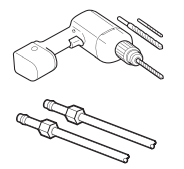
- If your existing copper water line has a flared fitting at the end, purchase an adapter (available at plumbing supply stores) to connect the water line to the refrigerator OR cut off the flared fitting with a tube cutter and then use a compression fitting. x Shutoff valve to connect to the cold water line.

- The shutoff valve should have a water inlet with a minimum inside diameter of 5/32 in. at the point of connection to the COLD WATER LINE. Saddle-type shutoff valves are included in many water supply kits. Before purchasing, make sure a saddle-type valve complies with your local plumbing codes.

Water Line Installation Instructions
Install the shutoff valve on the nearest frequently used drinking water line.
1. Shut off the main water supply.
Turn on the nearest faucet to relieve the pressure on the line.
2. Choose the valve location.
Choose a location for the valve that is easily accessible. It is best to connect into the side of a vertical water pipe. When it is necessary to connect into a horizontal water pipe, make the connection to the top or side, rather than at the bottom, to avoid drawing off any sediment from the water pipe
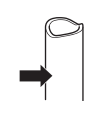
3. Drill the hole for the valve
- Drill the hole for the valve. x Drill a ¼ in. hole in the water pipe using a sharp bit. Remove any burrs resulting from drilling the hole in the pipe. Be careful not to allow water to drain into the drill. Failure to drill a ¼ in. hole may result in reduced ice production or smaller cubes.

4. Fasten the shutoff valve.
Fasten the shutoff valve to the cold water pipe with the pipe clamp.

5. Tighten the pipe clamp.
Tighten the clamp screws until the sealing washer begins to swell.
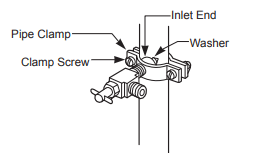
6.Route the tubing.
Route the tubing between the cold water line and the refrigerator.
Route the tubing through a hole drilled in the wall or floor ( behind the refrigerator or adjacent base cabinet) as close to the wall as possible.
7. Connect the tubing to the valve.
Place the compression nut and ferrule (sleeve) for copper tubing onto the end of the tubing and connect it to the shutoff valve.
Make sure the tubing is fully inserted into the valve. Tighten the compression nut securely.

8. Flush out the tubing.
Turn the main water supply on and flush out the tubing until the water is clear. Shut the water off at the water valve after about one quart of water has been flushed through the tubing.
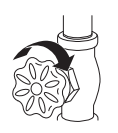
9. Connect the tubing to the refrigerator
NOTE
- Before making the connection to the refrigerator, be sure that the refrigerator power cord is not plugged into the wall outlet.
- Remove the plastic flexible cap from the water valve.
- Place the compression nut and ferrule (sleeve) onto the end of the tubing as shown.
- Insert the end of the copper tubing into the connection as far as possible. While holding the tubing, tighten the fitting.
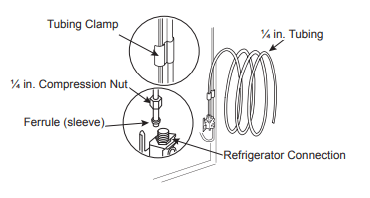
10. Turn the water on at the shutoff valve.
Tighten any connections that leak.
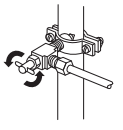
Leveling and Door Alignment
Leveling
The refrigerator has two front leveling legs. Adjust the legs to alter the tilt from front-to-back or side-to side. If the refrigerator seems unsteady, or the doors do not close easily, adjust the refrigerator’s tilt using the instructions below:
1. Turn the leveling leg to the left to raise that side of the refrigerator or to the right to lower it. It may take several turns of the leveling leg to adjust the tilt of the refrigerator.
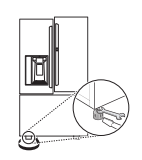
2. Open both doors and check to make sure that they close easily. If the doors do not close easily, tilt the refrigerator slightly more to the rear by turning both leveling legs to the left. It may take several more turns, and be sure to turn both leveling legs the same amount.
Door Alignment
Standard Door
Both the left and right refrigerator doors have an adjustable nut, located on the bottom hinge, to raise and lower them to align properly.
If the space between the doors is uneven, follow the instructions below to align the doors evenly:
Use the wrench (included with the owner's manual) to turn the nut in the door hinge to adjust the height. Turn the nut to the right to raise the door or to the left to lower it.
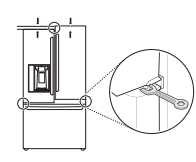
Door-in-Door
The left refrigerator door has an adjustable nut, located on the bottom hinge, to raise and lower the door for proper alignment.
If the space between the doors is uneven, follow the instructions below to align the left door:
Use the wrench (included with the owner's manual) to turn the nut in the door hinge to adjust the height.Turn the nut to the right to raise the door or to the left to lower it.
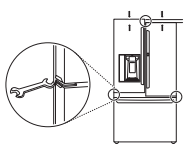
The right refrigerator door does not have an adjustable nut.
If the space between the doors is uneven, follow the instructions below to align the right door:
- With one hand, lift up both the inner and outer door sections of the right door to raise them at the middle hinge. (It may be easier to lift it with the doors open.)
- With the other hand, use pliers to insert the snap ring on the middle hinge of the inner door section as shown. Do not insert the ring on the hinge of the outer door section.
- Insert additional snap rings until the right door is aligned. (Two snap rings are provided with the unit.)
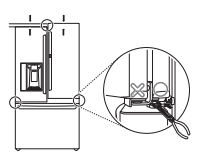
Turning on the Power
- After installing, plug the refrigerator’s power cord into a 3-prong grounded outlet and push the refrigerator into the final position
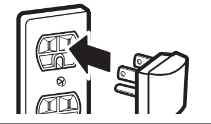
Position the Rrigerator
- Arrange the coil of tubing so that it does not vibrate against the back of the refrigerator or against the wall. Push the refrigerator back to the wall.
Start the Icemaker
- If the water line is connected, set the icemaker power switch to the ON position.
- The icemaker will not begin to operate until it reaches its operating temperature of 15 °F (–9 °C) or below. It will then begin operation automatically if the icemaker power switch is in the ON (I) position.
OPERATION
Before Use
Clean the refrigerator.

Clean the refrigerator thoroughly and wipe off all dust that accumulated during shipping.
Open refrigerator doors and freezer drawers to ventilate the interior.

The inside of the refrigerator may smell like plastic at first . Remove any adhesive tape from inside the refrigerator and open the refrigerator doors and the freezer drawers for ventilation.
Connect the power supply.
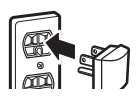
Check if the power supply is connected before use.
Turn off the icemaker

Turn off the icemaker if the refrigerator is not yet connected to the water supply.
Wait for the refrigerator to cool.

Allow the refrigerator to run for at least two to three hours before putting food in it. Check the flow of cold air in the freezer compartment to ensure proper cooling
The refrigerator makes a loud noise after initial operation.

This is normal. The volume will decrease as the temperature decreases.
Control Panel
Depending on the model, some of the following functions may not be available.
The actual control panel may differ from model to model.
Control Panel Features

1. Ice Type
Press the Ice Type button to choose either cubed or crushed ice. The Cubed or Crushed Ice icon illuminates.
2. Refrigerator Temperature
Indicates the set temperature of the refrigerator compartment in Celsius (°C) or Fahrenheit (°F). The default refrigerator temperature is 37 °F (3 °C). Press the Refrigerator button repeatedly to select a new set temperature from 33 °F to 46 °F (1°C to 8 °C).
3. Freezer Temperature
Indicates the set temperature of the freezer compartment in Celsius (°C) or Fahrenheit (°F). The default freezer temperature is 0°F (-18 °C). Press the Freezer button repeatedly to select a new set temperature from -6 °F to 8 °F (-21 °C to -13°C).
4. Smart Grid
Press the Smart Grid button to turn the Smart Grid function On/Off. When the function is on, the icon illuminates. The Smart Grid function automatically turns on when the refrigerator is connected to the Wi-Fi network.
When the refrigerator is responding to a Demand Response (DR) message from the electric company, the Grid text illuminates.
5. Wi-Fi (On Some Models)
The Wi-Fi button, when used with the LG
Smart Refrigerator smart phone app, allows the refrigerator to connect to a home Wi-Fi network.
Refer to Smart Function for information on the initial setup of the application.
The Wi-Fi icon shows the status of the refrigerator's network connection. The icon illuminates when the refrigerator is connected to the Wi-Fi network.
Press and hold the Wi-Fi button for 3 seconds to connect to the network. The icon blinks while the connection is being made, then turns on once the connection is successfully made.
6. Fresh Air Filter
The Fresh Air Filter helps remove odors from the refrigerator. The Fresh Air Filter has two settings, Auto and Power. In Auto mode, the Fresh Air Filter cycles on and off in increments of ten minutes on and 110 minutes off. If set to the Power mode, the Fresh Air Filter stays on continuously for four hours, cycling on and off in increments of ten minutes on and five minutes off. After four hours, the Fresh Air Filter switches back to Auto mode.
- Press the Fresh Air Filter button repeatedly to toggle between Power mode and Auto mode.
7. Ice Plus
This function increases both ice making and freezing capabilities.
- Press the Ice Plus button to illuminate the icon and activate the function for 24 hours. The function automatically shuts off after 24 hours.
- Stop the function manually by pressing the button once more.
8. Ice On/Off
Press the Ice On/Off button for three seconds to turn the icemaker on/off
9. Light
Press the Light button to turn on the dispenser light. The icon illuminates on the LED display.
10. Water Filter
Replace the water filter when the Replace Filter icon turns on. After replacing the water filter, press and hold the Water Filter button for three seconds to turn the icon light off. Replace the water filter approximately every six months.
11 . Door Alarm
When power is connected to the refrigerator, the door alarm is initially set to ON. Press the Door Alarm button to deactivate the Door Alarm function.
An alarm tone sounds when a refrigerator or freezer door is left open for more than 60 seconds. Close all doors to stop the alarm.
12. Lock
The Lock function disables every other button on the display.
- When power is initially connected to the refrigerator, the Lock function is off.
- To lock the control panel buttons, press and hold the Lock
 button until the closed Lock icon appears in the display and the function is activated.
button until the closed Lock icon appears in the display and the function is activated. - To disable the Lock function, press and hold the Lock button for approximately three seconds.
Ice and Water Dispenser
Dispenser Structure
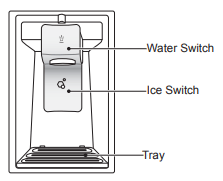
Using the Dispenser
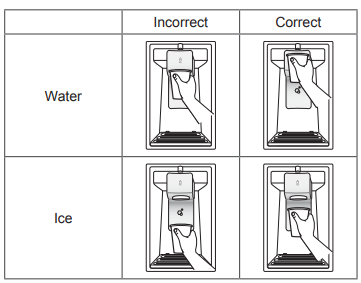
Locking the Dispenser
Press and hold the Lock button for three seconds to lock the dispenser and all the control panel functions. Follow the same instructions to unlock.
Cleaning the Dispenser Drip Tray
1. Grip the drip tray with both hands and pull it out.
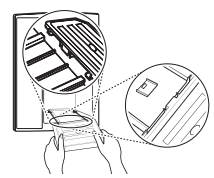
2. Wipe out dirty areas with a clean cloth.
Ice Compartment
Keep the ice compartment door closed tightly. If the ice compartment door is not closed tightly, the cold air in the ice bin will freeze food in the refrigerator compartment. This could also cause the icemaker to stop producing ice.
In-Door Ice Bin
The icemaker stops producing ice when the indoor ice bin is full. To make room for additional ice, empty the ice bin into the extra ice bin in the freezer compartment. During use, the ice may stack unevenly in the bin, causing the icemaker to misread the number of ice cubes and stop producing ice. Shaking the ice bin to level the ice within it can reduce this problem.
If the icemaker is turned OFF for an extended period of time, the ice compartment will gradually warm up to the temperature of the refrigerator compartment.
To prevent ice cubes from melting and leaking from the dispenser, ALWAYS empty the ice bin when the icemaker is turned OFF for more than a few hours.
The ice passage may become blocked with frost if only crushed ice is used. Remove the frost that accumulates by removing the ice bin and clearing the passage with a rubber spatula. Dispensing cubed ice can also help prevent frost buildup.
Detaching the In-Door Ice Bin
1. Gently pull the handle to open the ice compartment.

2. To remove the in-door ice bin, grip the front handle, slightly lift the lower part, and slowly pull out the bin as shown.
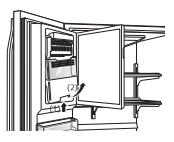
Assembling the In-Door Ice Bin
1. Carefully insert the in-door ice bin, slanting the top slightly to fit under the icemaker
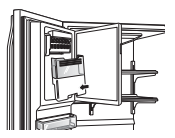
2. Gently push the handle to close the ice compartment.
Automatic Icemaker

- Ice is made in the automatic icemaker and sent to the dispenser. The icemaker produces 70 - 182 cubes in a 24-hour period, depending on freezer compartment temperature, room temperature, number of door openings and other operating conditions.
- It takes about 12 to 24 hours for a newly installed refrigerator to begin making ice.
- Ice-making stops when the in-door ice bin is full. When full, the in-door ice bin holds approximately 6 to 8 (12-16 oz.) glasses of ice.
- Foreign substances or frost on the ice-detecting sensor can interrupt ice production. Make sure the sensor area is clean at all times for proper operation.
- To increase ice production, use the Ice Plus function. The function increases both ice making and freezing capabilities.
Turning the Automatic Icemaker On
To turn the automatic icemaker On/Off, press and hold the Ice On/Off button on the control panel for three seconds.
Normal Sounds You May Hear
- Keeping the power turned on to the icemaker before the water line is connected can damage the icemaker.
- The icemaker water valve buzzes as the icemaker fills with water . If the Ice On/Off button is in the ON mode, it will buzz even if it has not yet been hooked up to water. To stop the buzzing, press the Ice On/ Off button to turn it off.
- You will hear the sound of cubes dropping into the bin and water running in the pipes as the icemaker refills
Preparing for Vacation
Set the Ice On/Off button to OFF and shut off the water supply to the refrigerator.
If the ambient temperature will drop below freezing, have a qualified technician drain the water supply system to prevent serious property amage due to flooding caused by ruptured water lines or connections.
Storing Food
Where to Store Food
Each compartment inside the refrigerator is designed to store different types of food.
Store food in the optimal space to enjoy the freshest taste.
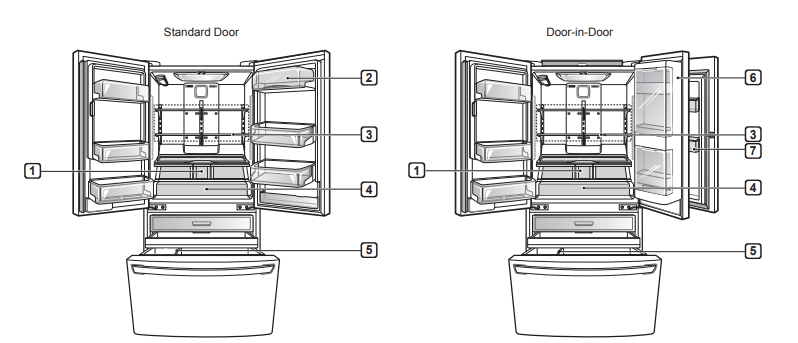
1. Vegetable Storage (Crisper)
Preserves vegetables and fruit.
2. Dairy Product Bin
Stores milk products such as butter and cheese.
3. Adjustable Refrigerator Shelf
Adjustable shelves to meet individual storage needs.
4. Glide‘N’Serve
Provides storage space with a variable temperature control that keeps the compartment at a different temperature than the refrigerator. It is a convenient place to store sandwiches or meat to be cooked.
5. Durabase®
Largest storage space in the freezer.
6. Door-in-Door Case
Convenient storage for frequently used items such as beverages, butter, margarine,cream cheese,peanut butter, and condiments.
7. Modular Door Bin
Stores drinks such as juice and soda, as well as condiments, salad dressings and other food items
Food Storage Tips
Wrap or store food in the refrigerator in airtight and moisture-proof material unless otherwise noted. This prevents food odor and taste transfer throughout the refrigerator. For dated products, check date code to ensure freshness.
- Butter or Margarine
- Keep opened butter in covered dish or closed compartment. When storing an extra supply, wrap in freezer packaging and freeze.
- Cheese
- Store in original wrapping until used. Once opened, rewrap tightly in plastic wrap or aluminum foil.
- Milk
- Wipe milk cartons. For coldest milk, place containers on an interior shelf.
- Eggs
- Store in original carton on interior shelf, not on door shelf.
- Fruit
- Do not wash or hull fruit until it is ready to be used. Sort and keep fruit in original container in a crisper, or store in completely closed paper bag on refrigerator shelf.
- Leafy Vegetables
- Remove store wrapping, trim or tear off bruised and discolored areas, wash in cold water, and drain. Place in plastic bag or plastic container and store in crisper.
- Vegetables with skins carrots, peppers)
- Place in plastic bags or plastic container and store in crisper.
- Fish
- Freeze fresh fish and shelifish if they are not being eaten the same day purchased . Eating fresh fish and shelifish the same day purchased is recommended.
- Leftovers
- Cover leftovers with plastic wrap or aluminum foil, or store in plastic containers with tight lids.
Storing Frozen Food
Check a freezer guide or a reliable cookbook for further information about preparing food for freezing or food storage times.
Freezing
Your freezer will not quick-freeze a large quantity of food. Do not put more unfrozen food into the freezer than will freeze within 24 hours (no more than 2 to pounds of food per cubic foot of freezer space).
Leave enough space in the freezer for air to circulate around packages. Be careful to leave enough room at the front so the door can close tightly.
Storage times will vary according to the quality and type of food, the type of packaging or wrap used how airtight and moisture-proof) and the storage temperature. Ice crystals inside a sealed package are normal. This simply means that moisture in the food and air inside the package have condensed, creating ice crystals.
Packaging
Successful freezing depends on correct packaging.
When you close and seal the package, it must not allow air or moisture in or out. If it does, you could have food odor and taste transfer throughout the refrigerator and could also dry out frozen food.
Packaging recommendations
- Rigid plastic containers with tight-fitting lids
- Straight-sided canning/freezing jars
- Heavy-duty aluminum foil
- Plastic-coated paper
- Non-permeable plastic wraps
- Specified freezer-grade self-sealing plastic bags
Follow package or container instructions for proper freezing methods.
Do not use
- Bread wrappers
- Non-polyethylene plastic containers
- Containers without tight lids
- Wax paper or wax-coated freezer wrap
- Thin, semi-permeable wrap
Glide‘N’Access™ (On Some Models)
The Glide’N’Access™ slides out for easy loading of large items, like sheet cakes or deli trays, and to provide easy access to items stored at the back of the shelf.
To slide out, grasp the handle at the front of the shelf and gently pull forward. Push back to slide in.
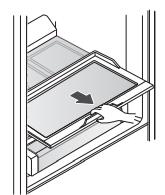
Humidity Controlled Crispers (On Some Models)
The crispers provide fresher tasting fruit and vegetables by letting you easily control humidity inside the drawer.
You can control the amount of humidity in the moisture-sealed crispers by adjusting the control to any setting between Vegetables and Fruit.
- Vegetables keeps moist air in the crisper for best storage of fresh, leafy vegetables.
- Fruit lets moist air out of the crisper for best storage of fruit.
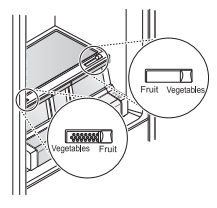
Glide‘N’Serve
The Glide’N’Serve provides storage space with a variable temperature control that can keep the compartment at a slightly different temperature than the refrigerator section. This drawer can be used for large party trays, deli items and beverages. (This drawer should not be used to store vegetables that require high humidity.)
Press the Select button to choose between Produce (Cold), Deli (Colder) and Meat (Coldest).

Durabase®
The Durabase® divider allows you to organize the Durabase® area into sections. It can be adjusted from side to side to accommodate items of different sizes.
Detaching/Assembling the Storage Bins
Some bins may vary in appearance and will only fit in one location.
Glide'N'Serve and Crispers
1. To remove the humidity controlled crispers and the Glide'N'Serve, pull out the crisper (1) and Glide'N'Serve (2) to full extension, lift the front up, and pull straight out.
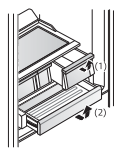
2. To install, slightly tilt up the front, insert the crisper or drawer into the frame and push it back into place.
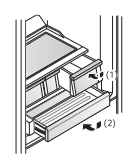
Glide‘N’Access™ (On Some Models)
1. To remove the Glide‘N’Access™, pull out the shelf to full extension, lift the front up and pull straight out.
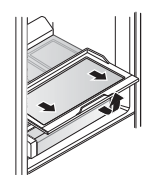
2. To install, slightly tilt up the front, insert the shelf into the frame and push it back into place.
Glass (On Some Models)
Lift up the glass under the crisper cover, and pull up and out.
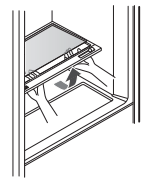
Door Bins
The door bins are removable for easy cleaning and adjustment.
- To remove the bin, simply lift the bin up and pull straight out.
- To replace the bin, slide it in above the desired support and push down until it snaps into place

Door-in-Door (On Some Models)
The Door-in-Door compartment allows for easy access to commonly used food items.
The outer Door-In-Door door includes two door bins, the Cheese & Butter and Condiment bins, that are specially designed for these items. Butter stored here will be easier to spread, cheese will be easier to slice, and condiments ready to use.
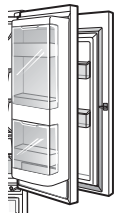
Door-in-Door Compartment
To access the Door-in-Door compartment, lightly press the button on the right refrigerator door handle.
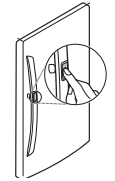
Door-in-Door Case
To open the Door-in-Door case, press on the area marked Press To Open. The Door-In- Door case is removable for easy cleaning and adjustment.
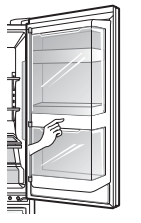
1. To remove the Door-In-Door case, lift up and pull out.
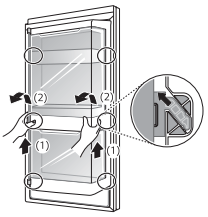
2. To replace the Door-in-Door case, line up the tabs on the Door-In-Door case with the slots on the door and push down until it snaps into place.
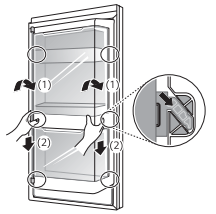
Door-in-Door Bin (On Some Models)
The Door-in-Door inner and outer door bins are removable for easy cleaning.
1. To remove the door bins, lift up and pull out.
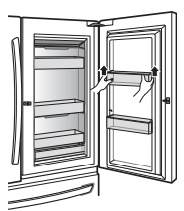
2. To replace the door bins, slide the door bin in above the desired support and push down until it snaps into place.
Door-in-Door Lower Shelf
The Door-In-Door lower shelf is removable for easy cleaning.
- To remove the lower shelf, lift the shelf retainer up and out.
- Remove the two screws from the shelf and pull it straight out.

Adjusting the Refrigerator Shelves
The shelves in the refrigerator are adjustable to meet individual storage needs. Your model may have full or split shelves.
Adjusting the shelves to fit items of different heights will make finding the exact item you want easier.
Detaching the Shelf
- Tilt up the front of the shelf and then lift the shelf straight up.
- Pull the shelf out.

Assembling the Shelf
- Tilt the front of the shelf up and guide the shelf hooks into the slots at a desired height.
- Lower the front of the shelf so that the hooks drop into the slots.
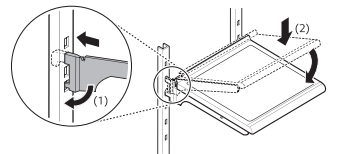
Using the Folding Shelf
Store taller items, such as a gallon container or bottles, by pushing the front half of the shelf underneath the back half of the shelf. Pull the front of the shelf forward to return to a full shelf.
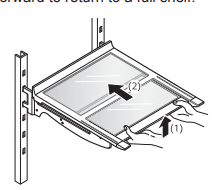
SMART FUNCTIONS
LG SmartThinQ Application
The LG SmartThinQ application allows you to communicate with the appliance using a smartphone.
Before Using LG SmartThinQ
- For appliances with the
 or
or  logo
logo
1. Use a smartphone to check the strength of the wireless router (Wi-Fi network) near the appliance.
- If the distance between the appliance and the wireless router is too far, the signal strength becomes weak. It may take a long time to register or installation may fail.
2. Turn off the Mobile data or Cellular Data on your smartphone.
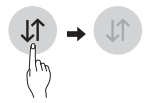
3. Connect your smartphone to the wireless router.
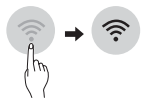
Installing the LG SmartThinQ Application
Search for the LG SmartThinQ application from the Google Play Store or Apple App Store on a smart phone. Follow instructions to download and install the application.
LG SmartThinQ Application Features
For appliances with the  or
or  logo
logo
Firmware Update
Keep the appliance performance updated.
Manage Food
This feature helps track items in the refrigerator and freezer, sends alerts when items are near their use by dates, generates grocery lists, and links to related recipes.
Energy Monitoring
This feature keeps track of the refrigerator’s power consumption and the number of door openings.
Remote Control
Control the Refrigerator Temperature, Fresh Air Filter and Ice Plus from the smart phone app.
Push Messages
If the door remains open for more than ten minutes, you will receive a push message. When Ice Plus is finished , you will recive a push message
Smart Diagnosis™
This function provides useful information for diagnosing and solving issues with the appliance based on the pattern of use.
Settings
Allows you to set various options on the refrigerator and in the application.
Wireless LAN Module Specifications
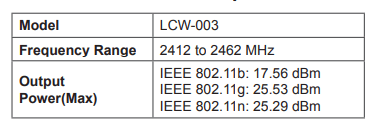
FCC Notice
- For transmitter module contained in this product
This equipment has been tested and found to comply with the limits for a Class B digital device, pursuant to Part 15 of the FCC Rules. These limits are designed to provide reasonable protection against harmful interference in a residential installation. This equipment generates, uses, and can radiate radio frequency energy and, if not installed and used in accordance with the instructions, may cause harmful interference to radio communications. However, there is no guarantee that interference will not occur in a particular installation. If this equipment does cause harmful interference to radio or television reception, which can be determined by turning the equipment off and on, the user is encouraged to try to correct the interference by one or more of the following measures:
- Reorient or relocate the receiving antenna.
- Increase the separation between the equipment and the receiver.
- Connect the equipment to an outlet on a circuit different from that to which the receiver is connected.
- Consult the dealer or an experienced radio/TV technician for help.
This device complies with part 15 of the FCC Rules. Operation is subject to the following two conditions:
- This device may not cause harmful interference and
- This device must accept any interference received, including interference that may cause undesired operation of the device.
Any changes or modifications in contruction of this device which are not expressly approved by the party responsible for compliance could void the user’s authority to operate the equipment.
FCC RF Radiation Exposure Statement
This equipment complies with FCC radiation exposure limits set forth for an uncontrolled environment. This transmitter must not be co-located or operating in conjunction with any other antenna or transmitter.
This equipment should be installed and operated with a minimum distance of 20 cm (7.8 inches) between the antenna and your body. Users must follow the specific operating intructions for satisfying RF exposure compliance.
Industry Canada Statement (For transmitter module in this product)
This device complies with Industry Canada’s applicable licence-exempt RSSs. Operation is subject to the following two conditions:
- This device may not cause interference ; and
- This device must accept any interference, including interference that may cause undesired operation of the device.
IC Radiation Exposure Statement
This equipment complies with IC radiation exposure limits set forth for an uncontrolled environment.
This equipment should be installed and operated with a minimum distance of 20 cm (7.8 inches) between the antenna and your body
Open Source Software Notice Information
To obtain the source code under GPL, LGPL, MPL, and other open source licenses, that is contained in this product
In addition to the source code, all referred license terms, warranty disclaimers and copyright notices are available for download.
LG Electronics will also provide open source code to you on CD-ROM for a charge covering the cost of performing such distribution (such as the cost of media, shipping, and handling) upon email request to [email protected]. This offer is valid for a period of three years after our last shipment of this product. This offer is valid to anyone in receipt of this information.
Smart Grid Function
When the refrigerator operates in Smart Grid mode, the Smart Refrigerator function can control energy usage or delay the operation of some functions to save energy during peak usage periods.
- You can override the Smart Grid function any time using the Smart Grid button or application).
- To use the Smart Grid function, you need to register your appliance with your electric utility company.
Smart Grid Application Features
Smart Saving_Demand Response
You can lower energy usage based on Demand
Response (DR) signals from the utility company. If the refrigerator is operating in Smart Saving mode according to the DR signal, you can see a pop up.
Seasonal Energy Savings
Lower energy usage based on time period.
Using the Smart Grid Function
This feature responds to notification events from your utility company to run high energy consuming tasks during off-peak periods when demand is lower. These notification events are known as Demand Response signals.
If the refrigerator receives a Demand Response signal from the utility company, the refrigerator will turn on the Grid LED on the refrigerator display and control its power consumption according to the signal.
The refrigerator will respond to the signals received from the utility company as long as product performance is maintained.
If the refrigerator receives a Demand Response signal, the refrigerator will operate in Delay Appliance Load (DAL) or Temporary Appliance Load Reduction TALR) mode.
Delay Appliance Load (DAL)
The refrigerator responds to a DAL signal by providing a moderate load reduction for the duration of the delay period.
This mode controls functions that consume a lot of energy such as adjusting the cooling system, running the defrost cycle, and making ice.
- When the refrigerator operates in DAL mode, the Grid LED is illuminated on the refrigerator display.
- DAL mode is automatically deactivated after the period stipulated by the DAL signal (max. 4 hours) or when you override the Smart Grid function.
Temporary Appliance Load Reduction (TALR)
The refrigerator responds to a TALR signal by aggressively reducing the load for a short time period, typically 10 minutes. This mode reduces energy consumption by stopping the compressor and controlling the functions that consume a lot of energy such as the defrost cycle and fan.
- When the refrigerator operates in TALR mode, the Grid LED is illuminated on the refrigerator display.
- TALR mode is automatically deactivated after the received duration (max. 10 minutes), or when you override the Smart Grid function. The mode is immediately deactivated and the refrigerator returns to its normal state when the door is opened or closed, or the dispenser is used.
Override Smart Grid Mode
To ignore the Demand Response signal from the utility company and override the Smart Grid function, push the Smart Grid button while the refrigerator is in Smart Grid mode.
When you override the Smart Grid function, the refrigerator ignores the Demand Response signal and is no longer controlled by the utility company until the next Demand Response signal is sent. You can also override the Smart Grid function using the smart phone app.
LG Open API
You can manage Smart Grid features for the LG Smart Refrigerator.
API list
Demand Response
- Send demand response signal
Power Saving
- Set saving mode
- Get schedule of DR/Delay Defrost
Energy Monitoring
- Get door open event
- Get energy consumption
Delay Defrost Capability
- Insert a delay defrost schedule event
- Update a delay defrost schedule event
- Delete a delay defrost schedule event
Get the delay defrost schedule
Smart Diagnosis™ Function
Should you experience any problems with the appliance, it has the capability of transmitting data via your telephone to the LG Customer Information Center. NFC or Wi-Fi equipped models can also transmit data to a smartphone using the LG Smart ThinQ application.
Smart Diagnosis™ through the Customer Information Center
- For appliances with the
 or
or  logo
logo
This gives you the capability of speaking directly to our trained specialists. The specialist records the data transmitted from the appliance and uses it to analyze the issue, providing a fast and effective diagnosis.
1. Call the LG Electronics Customer Information
Center at:
LG U.S.A.) 1-800-243-0000
LG Canada) 1-888-542-2623
2. Hold the Lock button for three seconds
- If the display has been locked for over five minutes, you must deactivate the lock and then reactivate it.

3. Open the right refrigerator door.
4. Hold the mouthpiece of your phone in front of the speaker that is located on the right hinge of the refrigerator door, when instructed to do so by the call center.
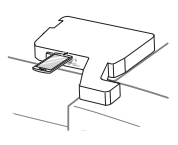
5. Press and hold the Freezer button for three seconds while continuing to hold your phone to the speaker.
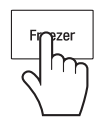
6. After you hear three beeps, release the Freezer button.
7. Keep the phone in place until the tone transmision has finished . The display will count down the time. Once the countdown is over and the tones have stopped, resume your conversation with the specialist, who will then be able to assist you in using the information transmitted for analysis.
LG SmartThinQ Smart Diagnosis™
- For appliances with the
 or
or  logo
logo
Use the Smart Diagnosis feature in the LG
SmartThinQ application for help diagnosing issues with the appliance without the assistance of the LG Customer Information Center.
Follow the instructions in the LG SmartThinQ application to perform a Smart Diagnosis using your smartphone.
MAINTENANCE
Cleaning
General Cleaning Tips
- Both the refrigerator and freezer sections defrost automatically ; however , clean both sections once a month to prevent odors month to prevent odors.
- Wipe up spills immediately.
- Unplug the refrigerator or disconnect power before cleaning.
- Remove all removable parts, such as shelves.
- Use a clean sponge or soft cloth and a mild detergent in warm water. Do not use abrasive or harsh cleaners.
- Hand wash, rinse and dry all surfaces thoroughly.
Exterior
Waxing external painted metal surfaces helps provide rust protection. Do not wax plastic parts. Wax painted metal surfaces at least twice a year using appliance wax (or auto paste wax). Apply wax with a clean, soft cloth.
For products with black stainless steel exterior, spray glass cleaner on a clean , microfiber cloth and rub in direction of grain. Do not spray glass cleaner directly at the display panel. Do not use harsh or abrasive cleaners.
For products with a standard stainless steel exterior, use a damp microfiber cloth and rub in the direction of the grain. Dry with a paper towel to avoid streaks. For stubbom stains and fingerprints , use a few drops of liquid dish soap in water, and rinse with hot water before drying. Do not use abrasive or harsh cleaners.
Inside Walls
- Allow freezer to warm up so the cloth will not stick.
To help remove odors, wash the inside of the refrigerator with a mixture of baking soda and warm water. Mix 2 tablespoons of baking soda to 1 quart of water (26 g soda to 1 liter water.) Be sure the baking soda is completely dissolved so it does not scratch the surfaces of the refrigerator.
Door Liners and Gaskets
Use a clean sponge or soft cloth and a mild detergent in warm water. Do not use cleaning waxes, concentrated etergents, bleaches, or cleaners containing petroleum on plastic refrigerator parts.
Plastic Parts (covers and panels)
Use a clean sponge or soft cloth and a mild detergent in warm water. Do not use glass cleaners, abrasive clensers, or flammable fluids . These can scratch or damage the material.
Condenser Coils
Use a vacuum cleaner with a brush or crevice attachment to clean the condenser cover and vents. Do not remove the panel covering the condenser coil area.
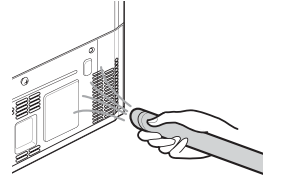
Replacing the Fresh Air Filter
Replace the Fresh Air Filter:
- Approximately every six months.
- When the Replace Filter
 icon turns on.
icon turns on.

1. Turn the filter cover to the left to detach it from the refrigerator wall. Remove the filter from the cover.
- The filter is located on the inside of the filter cover.
2. Place the new filter inside of the cover with the side that says Front facing outward.
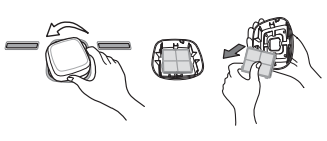
3. Turn the filter cover to the right to attach it to there frigerator wall
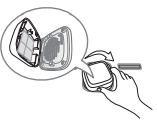
4. Press and hold the Fresh Air Filter button for three seconds to reset the filter sensor.

Replacing the Water Filter
Replace the Water Filter :
- Approximately every six months.
- When the Replace Filter
 icon turns on.
icon turns on. - When the water dispenser output decreases.
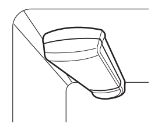
Before Replacing the Water Filter:
If the top shelf, located below the water filter, is in the highest position, it will need to be removed prior to replacing the water filter.
To remove any shelf: Tilt up the front of the shelf (1) and lift (2). Pull the shelf out.
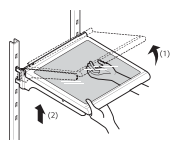
1. Remove the old water filter.
Lower or remove the top left shelf to allow the water filter to rotate all the way down.
Pinch the sides to open the water filter cover.
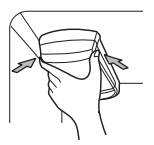
2. Pull the water filter downward and pull out. Make sure to rotate the filter down completely before pulling it out of the manifold hole.
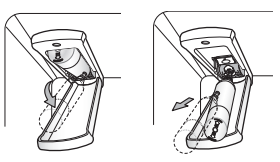
3. Replace with a new water filter.
Take the new water filter out of its packing and remove the protective cover from the o-rings. With the water filter tabs in the horizontal position, push the new water filter into the manifold hole until it stops.

4. Rotate the water filter up into position and close the cover. The cover will click when closed correctly.
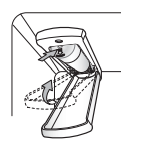
5. After the water filter is replaced, dispense 2.5 gallons of water (flush for approximately 5 minutes) to remove trapped air and contaminants from the system.
6. After changing the filter, press and hold the Water Filter button for three seconds to reset the indicator light.


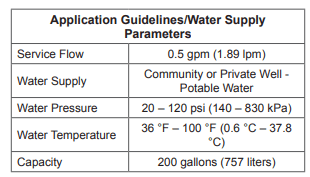
It is essential that the manufacturer’s recommended installation , maintenance and filter replacement requirements be carried out for the product to perform as advertised.
TROUBLESHOOTING
FAQs: Frequently Asked Questions
Q : What are the best temperature settings for my refrigerator and freezer?
A: The default setting for the refrigerator is 37° Fahrenheit (3° Celsius). The default setting for the freezer is 0 Fahrenheit (-18° Celsius) Adjust these settings as necessary to keep food at desired temperatures Milk should be cold when stored on the inner shelf of the refrigerator. Ice cream should be firm and ice cubes should not melt in the freezer. To switch the display from Fahrenheit to Celsius, press and hold the Freezer and Refrigerator buttons until you hear a beep and the settings in the display change.
Q: How do I set the refrigerator and freezer temperatures?
A: Continually press the Refrigerator or Freezer button on the control panel until the desired temperature appears. The numbers will cycle from highest to lowest and then return to the highest again with continuous pressing
Q: Why do I hear a buzzing noise from my refrigerator periodically?
A: This may happen if you do not have a water source attached to your refrigerator and the icemaker is turned on. If you do not have a water source attached to the back of the refrigerator you should turn the cemaker off
See other models: LSXS26326S DLE3500W LTCS20120W LSR100 GMX936SBHV
Q: Why does the icemaker tray look crooked?
This is a normal part of the icemaker cycle. The icemaker tray may appear level of with a slight tilt .The change in position is to assist in the freezing process.
Q: My refrigerator is powered on and the controls are working, but it's not cooling and the display shows "OFF" (see below). What is wrong?
A: The refrigerator is in Demo Mode This mode disables cooling to save energy while the appliance is on display in a store. To restore normal operation press and hold the Refrigerator and Ice Plus buttons for 5 seconds or until you hear a beep and the temperature settings appear on the display .Use the same procedure to return the refrigerator to Dema Mode if desired .

Before Calling for Service
Review this section before calling for service; doing so will save you both time and money.
Cooling
Refrigerator and Freezer section are not cooling.
- The refrigerator control is set to OFF (some models).
- Turn the control ON. Refer to the Setting the Controls section for proper temperature settings.
- Refrigerator is set to Demo Mode.
- Demo Mode allows the lights and control display to work normally while disabling cooling, to save energy while the refrigerator is on the showroom floor. See the FAQs section of this manual for instructions on how to disable Demo Mode.
- Refrigerator is in the defrost cycle.
- During the defrost cycle, the temperature of each compartment may rise slightly. Wait 30 minutes and confirm the proper temperature has been restored once the defrost cycle has completed.
- Refrigerator was recently installed.
- It may take up 24 hours for each compartment to reach the desired temperature
- Refrigerator was recently relocated.
- If the refrigerator was stored for a long period of time or moved on its side, it is necessary for the refrigerator to stand upright for 24 hours before connecting it to power.
Cooling system runs too much.
- Refrigerator is replacing an older model.
- Modern refrigerators require more operating time but use less energy due to more efficient technology.
- Refrigerator was recently plugged in or power restored.
- The refrigerator will take up to 24 hours to cool completely.
- The door is opened often or a large amount of food / hot food was added.
- Adding food and opening the door warms the refrigerator, requiring the compressor to run longer in order to cool the refrigerator back down. In order to conserve energy, try to get everything you need out of the refrigerator at once, keep food organized so it is easy to find, and close the door as soon as the food is removed. (Refer to the Food Storage Guide.)
- Doors are not closed completely.
- Firmly push the doors shut. If they will not shut all the way, the "Doors will not close correctly or pop open" section.
- Refrigerator is installed in a hot location.
- The compressor will run longer under warm conditions. At normal room temperatures (70 °F) expect your compressor to run about 40 % to 80% of the time. Under warmer conditions, expect it to run even more often. The refrigerator should not be operated above 110 °F.
- Condenser / back cover is clogged.
- Use a vacuum cleaner with an attachment to clean the condenser cover and vents. Do not remove the panel covering the condenser coil area.
Interior moisture buildup.
- Doors are opened often or for long periods of time.
- When the doors are opened often or for long periods of time, warm, humid air enters the compartment. This raises the temperature and moisture level within the compartment. To lessen the effect, reduce the frequency and duration of door openings.
- Doors are not closed correctly.
- See the "Doors will not close correctly or pop open" section.
- Weather is humid
- Humid weather allows additional moisture to enter the compartments when the doors are opened leading to condensation or frost. Maintaining a reasonable level of humidity in the home will help to control the amount of moisture that can enter the compartments.
- Defrost cycle recently completed.
- During the defrost cycle, the temperature of each compartment may rise slightly and condensation may form on the back wall.Wait 30 minutes and confirm that the proper temperature has been restored once the defrost cycle has completed.
- Food is not packaged correctly.
- Food stored uncovered or unwrapped, and damp containers can lead to moisture accumulation within each compartment. Wipe all containers dry and store food in sealed packaging to prevent condensation and frost
Food is freezing in the refrigerator compartment.
- Food with high water content was placed near an air vent.
- Rearrange items with high water content away from air vents.
- Refrigerator temperature control is set incorrectly.
- If the temperature is too cold, adjust the control one increment at a time and wait for the temperature to stabilize. Refer to the Control Panel section for more information.
- Refrigerator is installed in a cold location.
- When the refrigerator is operated in temperature below 41°F (5°C), food can freeze in the refrigerator compartment. The refrigerator should not be operated in temperature below 55°F (13°C).
Refrigerator or Freezer section is too warm.
- Refrigerator was recently installed.
- It may take up to 24 hours for each compartment to reach the desired temperature.
- The air vents are blocked. Cold air circulates from the freezer to the fresh food section and back again through air vents in the wall dividing the two sections.
- Locate air vents by using your hand to sense airflow and move all packages that block vents and restrict airflow. Rearrange items to allow air to flow throughout the compartment.
Cooling/Ice & Water
Refrigerator or Freezer section is too warm.
- Doors are opened often or for long periods of time.
- When the doors are opened often or for long periods of time, warm, humid air enters the compartment. This raises the temperature and moisture level within the compartment. To lessen the effect, reduce the frequency and duration of door openings.
- Unit is installed in a hot location.
- The refrigerator should not be operated in temperatures above 110 °F.
- A large amount of food or hot food was added to either compartment.
- Adding food warms the compartment requiring the cooling system to run. Allowing hot food to cool to room temperature before putting it in the refrigerator will reduce this effect.
- Doors not closed correctly.
- See the Doors will not close correctly or pop open section in Parts & Features Troubleshooting.
- Temperature control is not set correctly.
- If the temperature is too warm, adjust the control one increment at a time and wait for the temperature to stabilize.
- Defrost cycle has recently completed.
- During the defrost cycle, the temperature of each compartment may rise slightly and condensation may form on back wall. Wait 30 minutes and confirm the proper temperature has been restored once the defrost cycle has completed.
Refrigerator or Freezer section is too cold.
- Incorrect temperature control settings.
- If the temperature is too cold, adjust the control one increment at a time and wait for the temperature to stabilize. Refer to the Control Panel for more information
Frost or ice crystals form on frozen food (inside of sealed package).
- Condensation from food with a high water content has frozen inside of the food package.
- This is normal for food items with a high water content.
- Food has been left in the freezer for a long period of time.
- Do not store food items with high water content in the freezer for a long period of time.
Frost or ice crystals form on frozen food (outside of package).
- Door is opened frequently or for long periods of time.
- When the doors are opened often or for long periods of time, warm, humid air enters the compartment. This raises the temperature and moisture level within the compartment. Increased moisture will lead to frost and condensation. To lessen the effect, reduce the frequency and duration of door openings.
- Door is not closing properly.
- Refer to the Doors will not close correctly or pop open section in the Troubleshooting section.
Ice & Water
Icemaker is not making enough ice.
- Demand exceeds ice storage capacity.
- The icemaker will produce approximately 70-184 cubes in a 24 hour period.
- House water supply is not connected, valve is not turned on fully, or valve is clogged.
- Connect the refrigerator to a cold water supply with adequate pressure and turn the water shutoff valve fully open. If the problem persists, it may be necessary to contact a plumber.
- Water filter has been exhausted.
- Replacing the water filter is recommended
- Approximately every six months.
- When the water filter indicator turns on.
- When the water dispenser output decreases.
- When the ice cubes are smaller than normal.
- Low house water supply pressure.
- The water pressure must be between 20 and 120 psi on models without a water filter and between 40 and 120 psi on models with a water filter. If the problem persists, it may be necessary to contact a plumber.
- Reverse Osmosis filtration system is used.
- Reverse osmosis filtration systems can reduce the water pressure below the minimum amount and result in icemaker issues. (Refer to the Connecting the Water Line section.)
- Tubing connecting refrigerator to house supply valve is kinked.
- The tubing can kink when the refrigerator is moved during installation or cleaning resulting in reduced water flow. Straighten or repair the water supply line and arrange it to prevent future kinks.
- Doors are opened often or for long periods of time.
- If the doors of the unit are opened often, ambient air will warm the refrigerator which will prevent the unit from maintaining the set temperature. Lowering the refrigerator temperature can help, as well as not opening the doors as frequently.
- Doors are not closed completely.
- If the doors are not properly closed, ice production will be affected. See the "Doors will not close correctly or pop open" section in Parts & Features Troubleshooting for more information.
- The temperature setting for the freezer is too warm.
- The recommended temperature for the freezer compartment for normal ice production is 0°F. If the freezer temperature is warmer, ice production will be affected.
Icemaker is not making ice
- Refrigerator was recently installed or icemaker recently connected.
- It may take up to 24 hours for each compartment to reach the desired temperature and for the icemaker to begin making ice.
- Icemaker not turned on
- Locate the icecream ON/OFF and confirm that it is turned on.
- The ice detecting sensor is obstructed.
- Foreign substances or frost on the ice-detecting sensor can interrupt ice production. Make sure that the sensor area is clean at all times for proper operation.
- The refrigerator is not connected to a water supply or the supply shutoff valve is not turned on.
- Connect the refrigerator to the water supply and turn the water shutoff valve fully open.
- Icemaker shutoff (arm or sensor) obstructed.
- If your icemaker is equipped with an ice shutoff arm, make sure that the arm moves freely. If your icemaker is equipped with the electronic ice shutoff sensor, make sure that there is a clear path between the two sensors.
- Reverse osmosis water filtration system is connected to your cold water supply.
- Reverse osmosis filtration system can reduce the water pressure below the minimum amount and result in icemaker issues. (Refer to the Connecting the Water Line section.)
Ice has bad taste or odor.
- Water supply contains minerals such as sulfur.
- A water filter may need to be installed to elimiante taste and odor problems .
- Icemaker was recently installed.
- Ice that has been stored for too long will shrink, become cloudy, and may develop a stale taste. Throw away old ice and make a new supply.
- The food has not been stored properly in either compartment.
- Rewrap the food. Odors may migrate to the ice if food is not wrapped properly
- The interior of the refrigerator needs to be cleaned.
- See the Maintenance section for more information
- The ice storage bin needs to be cleaned.
- Empty and wash the bin (discard old cubes). Make sure that the bin is completely dry before reinstalling it.
Icemaker is making too much ice.
- Icemaker shutoff (arm/ sensor) is obstructed.
- Empty the ice bin. If your icemaker is equipped with an ice shutoff arm, make sure that the arm moves freely. If your icemaker is equipped with the electronic ice shutoff sensor, make sure that there is a clear path between the two sensors. Reinstall the ice bin and wait 24 hours to confirm proper operation
Ice is not dispensing.
- Unable to hear the sound of ice coming out?
- In the control panel, select the modes for cubed ice and crushed ice alternately to dispense the ice.
- Doors are not closed completely.
- Ice will not dispense if any of the refrigerator doors are left open.
- Infrequent use of the dispenser.
- Infrequent use of the ice dispenser will cause the cubes to stick together over time, which will prevent them from properly dispensing. Check the ice bin for ice cubes clumping/sticking together. If they are, break up the ice cubes to allow for proper operation.
- The delivery chute is clogged with frost or ice fragments.
- Eliminate the frost or ice fragments by removing the ice bin and clearing the chute with a plastic utensil. Dispensing cubed ice can also help prevent frost or ice fragment buildup.
- The dispenser display is locked.
- Press and hold the Lock button for three seconds to unlock the control panel and dispenser.
- Ice bin is empty.
- It may take up to 24 hours for each compartment to reach the desired temperature and for the icemaker to begin making ice. Make sure that the shutoff (arm/ sensor) is not obstructed. Once the ice supply in the bin has been completely exhausted, it may take up to 90 minutes before additional ice is available, and approximately 24 hours to completely refill the bin
Water is dispensing slowly.
- Water filter has been exhausted
- Replacing the water filter is recommended
- Approximately every six months.
- When the water filter indicator turns on.
- When the water dispenser output decreases.
- When the ice cubes are smaller than normal.
- Low house water supply pressure.
- The water pressure must be between 20 and 120 psi on models without a water filter and between 40 and 120 psi on models with a water filter. If the problem persists, it may be necessary to contact a plumber.
Water is not dispensing.
- New installation or water line recently connected.
- Dispense 2.5 gallons of water ( flush for approximately 5 minutes) to remove trapped air and contaminants from the system. Do not dispense the entire 2.5 gallon amount continuously. Depress and release the dispenser pad for cycles of 30 seconds ON and 60 seconds OFF.
- The dispenser panel is locked.
- Press and hold the Lock button for three seconds to unlock the control panel and dispenser.
- The dispenser is not set for water dispensing.
- The dispenser can be set for ice or water. Make certain that the control panel is set for the proper operation. Press the Water button on the control panel to dispense water.
- Refrigerator or freezer doors are not closed properly
- Water will not dispense if any of the refrigerator doors are left open.
- Water filter has been recently removed or replaced.
- After the water filter is replaced, dispense 2.5 gallons of water ( flush for approximately five minutes ) to remove trapped air and contaminants from the system. Do not dispense the entire 2.5 gallon amount continuously. Depress and release the dispenser pad for cycles of 30 seconds ON and 60 seconds OFF.
- Tubing connecting refrigerator to house supply valve is kinked.
- The tubing can kink when the refrigerator is moved during installation or cleaning. Resulting in reduced water flow . Straighten or repair the water supply line and arrange it to prevent future kinks.
- The house water supply is not connected, the valve is not turned on fully, or the valve is clogged.
- Connect the refrigerator to the water supply and turn the water shutoff valve fully open. If the problem persists, it may be necessary to contact a plumber.
Dispensing warm water.
- The water dispenser has been used recently and the storage tank was exhausted.
- Depending on your specific model , the water storage capacity will range from approximately 20 to 30 oz.
- Dispenser has not been used for several hours.
- If the dispenser has not been used for several hours, the first glass dispensed may be warm . Discard the first 10 oz.
- Refrigerator is connected to the hot water supply
- Make sure that the refrigerator is connected to a cold water pipe.
Water has bad taste or odor.
- Water filter has been exhausted
- Replacing the water filter is recommended
- Approximately every six months.
- When the water filter indicator turns on.
- When the water dispenser output decreases.
- When the ice cubes are smaller than normal.
- Refrigerator was recently installed.
- Dispense 2.5 gallons of water ( flush for approximately 5 minutes) to remove trapped air and contaminants from the system. Do not dispense the entire 2.5 gallon amount continuously. Depress and release the dispenser pad for cycles of 30 seconds ON and 60 seconds OFF.
Parts & Features
Doors will not close correctly or pop open.
- Food packages are blocking the door open.
- Rearrange food containers to clear the door and door shelves.
- Ice bin, crisper cover, pans, shelves, door bins, or baskets are out of position.
- Push bins all the way in and put crisper cover, pans, shelves and baskets into their correct positions. See the Operation section for more information.
- The doors were removed during product installation and not properly replaced.
- Remove and replace the doors according to the Removing and Replacing Refrigerator Handles and Doors section.
- Refrigerator is not leveled properly.
- See Door Alignment in the Refrigeration Installation section to level refrigerator.
Doors are difficult to open.
- The gaskets are dirty or sticky.
- Clean the gaskets and the surfaces that they touch. Rub a thin coat of appliance polish or kitchen wax on the gaskets after cleaning.
- Door was recently closed.
- When you open the door, warmer air enters the refrigerator. As the warm air cools, it can create a vacuum. If the door is hard to open, wait one minute to allow the air pressure to equalize, then see if it opens more easily.
Refrigerator wobbles or seems unstable
- Leveling legs are not adjusted properly.
- Refer to the Leveling and Door Alignment section.
- Floor is not level.
- It may be necessary to add shims under the leveling legs or rollers to complete installation.
Lights do not work.
- LED interior lighting failure.
- The refrigerator compartment lamp is LED interior lighting , and service should be performed by a qualified technician
Refrigerator has an unusual odor.
- The Air Filter may need to be set to the MAX setting or replaced.
- Set the Air Filter to the MAX setting. If the odor does not go away within 24 hours , the filter may nees to be replaced. See the Replacing the Air Filter section for replacement instructions.
The interior of the refrigerator is covered with dust or soot.
- The refrigerator is located near a fire source , such as a fire place , chimney , or candle
- Make sure tha the refrigerator is not located near a fire source , such as a fire place , chimney , or candle
Noises
Clicking
- The defrost control will click when the automatic defrost cycle begins and ends. The thermostat control (or refrigerator control on some models) will also click when cycling on and off.
- Normal Operation
Rattling
- Ratting noises may come from the flow of refrigerant, the water line on the back of the unit, or items stored on top of or around the refrigerator.
- Normal Operation
- Refrigerator is not resting solidly on the floor
- Floor is weak or uneven or leveling legs need to be adjusted. See the Leveling and Door Alignment section.
- Refrigerator with linear compressor was jarred while running
- Normal Operation
Whooshing
- Evaporator fan motor is circulating air through the refrigerator and freezer compartments.
- Normal Operation
- Air is being forced over the condenser by the condenser fan.
- Normal Operation
Gurgling
- Refrigerator flowing through the cooling system.
- Normal Operation
Popping
- Contraction and expansion of the inside walls due to changes in temperature.
- Normal Operation
Sizzling
- Water dripping on the defrost heater during a defrost cycle.
- Normal Operation
Vibrating
- If the side or back of the refrigerator is touching a cabinet or wall, some of the normal vibrations may make an audible sound.
- To eliminate the noise, make sure that the sides and back cannot vibrate against any wall or cabinet.
Dripping
- Water running into the drain pan during the defrost cycle.
- Normal Operation
Pulsating or highpitched sound
- Your refrigerator is designed to run more effciently to keep your food items at the desired temperature. The high effciently compressor may cause yous new refrigerator to run longer than your old one, but it is still more energy effciently than previous models . While the refrigerator is running, it is normal to hear a pulsating or high-pitched sound.
- Normal Operation
Trouble connecting appliance and smartphone to Wi-Fi network
- The password for the Wi-Fi network was entered incorrectly.
- Delete your home Wi-Fi network and begin the registration process again.
- Mobile data for your smartphone is turned on.
- Turn off the Mobile data on your smartphone before registering the appliance.
- The wireless network name (SSID) is set incorrectly.
- The wireless network name (SSID) should be a combination of English letters and numbers. (Do not use special characters.)
- The router frequency is not 2.4 GHz.
- Only a 2.4 GHz router frequency is supported. Set the wireless router to 2.4 GHz and connect the appliance to the wireless router. To check the router frequency, check with your Internet service provider or the router manufacturer.
- The distance between the appliance and the router is too far.
- If the appliance is too far from the router, the signal may be weak and the connection may not be configured correctly . Move the router closer to the appliance or purchase and install a Wi-Fi repeater.
